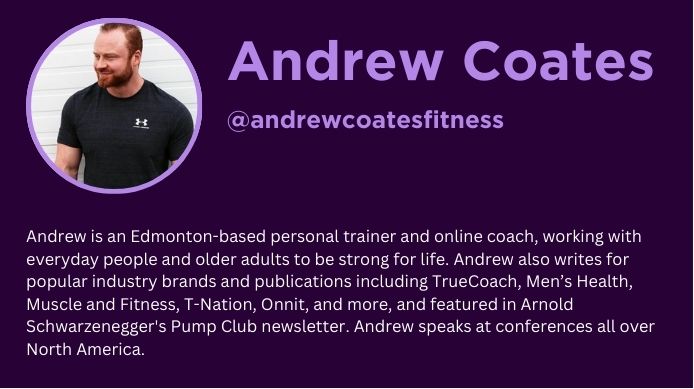Coaches with large social media followings love to tell you that you don’t need a large social media following to be a successful online coach. Are they right? Technically yes(though it can help – more on this later).
What really matters? Relationships with people that like and trust you who know what you do. And positive word of mouth so you’re attracting new clients faster than you’re losing them. Social media is just a way to magnify this.

The average coach needs between 20-60 clients to earn a good livelihood. $200 per month x 20 people is $4000 a month. $4000 could be more than enough depending on where and how you live. $300 per month x 60 clients is $18,000 per month. ($216,000 per year!). You can plug and play any combination of your monthly rate x your number of clients within or even beyond these ranges to project what you need. This also presumes you have zero in person clients and revenue.
Most coaches start with at least some in-person clients and are often already at least meeting their cost of living from their in person work. This takes pressure off the pace you scale your online business. Growing your online business then becomes a way to grow your livelihood and create more freedom.
Without factoring in extra followers who find your fitness content, most people have at least several hundred to a few thousand loose social connections and acquaintances. Getting 20 people to work with you should be more than possible if you’re doing a good job of nurturing your relationships and showcasing your work and knowledge.
Here’s what to focus on to grow your online coaching business:
1) Nurture your relationships
Be “of service” to your existing clientele. The best tactic to create a client is keeping an existing client happy and having them refer people (more on this later). Treat the client in front of you (virtually or in-person) as if your entire livelihood depends on it.
One of the reasons clients stop working with you is because they move away. If they know about your online coaching, often in-person clients are happy to continue to work with you because of existing trust. They’re often skilled enough to function independently, and may value the lower relative cost of online coaching, while having everything structured for them as they transition to a new city and life.
Everyone is wary of the high school acquaintance who materialize after years wanting to meet up for coffee with a “great business opportunity”, but people are genuinely happy to hear from and interact with old friends and contacts. We’re still on guard and expect some type of pitch. Here’s the key: don’t pitch or sell. Be genuine, be interested, be helpful. Leave the breadcrumbs so they know you’re there when ready to ask.
2) Stay Top of Mind In Your Network
This happens 3 ways, be connected to everyone you know via social media, be visible in your local in-person network, and be interactive via messaging (detailed in section 3).
Social media – Even without worrying about aggressive growth, be on, be active, and be engaged on select social media platforms. Trying to do them all is overwhelming and counter productive, but choose a few that suit the dynamic of your network. Facebook and Instagram are your most obvious and basic hubs. Friend and follow everyone you know, most will accept and follow back. Post consistent valuable fitness content that keeps you top of mind.
Your goal is to become their go to person for all things fitness, healthy lifestyle, and nutrition. Make strategic calls to action to direct people to your resources like articles, In-person visibility – While online coaching isn’t limited to your local network, it’s likely your starting point. The people you know consume coaching in different ways and sometimes move away. There’s also nothing wrong with people asking about in-person coaching.
Your goal is to maximize your surface area of luck. You can’t hide in your basement and wait for people to come to you, this means getting out in the world and meeting people. My friend Mike Doehla, founder of Stronger U, suggests having a sticker on your laptop that says what you do, and sit in coffee shops to do work(that you have to do anyway). Don’t wear headphones so you’re welcoming and accessible.
It’s also not about being transactional, but finding personal fulfillment in new situations that create new(and nurture existing) relationships. If potential clients are a byproduct of you doing things you enjoy, that’s win-win.
Your surface area of luck means being in more places and situations that could lead to more opportunities. It also relies upon having the skills and ability to take advantage of opportunities when they arise. You can’t get lucky if you aren’t in the room. This could be attending local conventions (comics, wine and beer, tattoos), festivals, concerts, networking events, charity events.
Sometimes taking an extra part time job in the service industry is a fun way to make extra money short term as you build your business while meeting new people. I worked the door of night club early in my career with a group of buddies(we were frequenting bars so we decided to party less and make money). It was just as social, if not more so, as people felt comfortable interacting with staff. I made a lot of great friends and numerous contacts from that world eventually ended up coaching with me.
3) Messaging and Client Interactions
Many in-person coaches fail to believe in online coaching because they don’t understand how to recreate the “human interaction”. We have to go way beyond spreadsheets and emails to deepen relationships.
Your best weapons here are voice and video messages. Message me right now on Instagram, tell me you’re reading this article, and I’ll respond with more than just a bland text auto response. Let people hear your voice and see your face. If video calls are part of your check in process, this goes a long way.
In addition to my one on one online coaching, I run a 13 week cohort based online women’s strength program. When I’m promoting an intake on social media, I respond to each inquiry with a personalized video message. People are usually surprised and the personal touch goes a long way to distinguishing the experience they will get. ManyChat dm automation may save you time down the road, but has no business in your systems when you’re starting out, in desperate need of clients, and burdened with an over abundance of free time.
Go above and beyond just “responding within 24 hours”. Go above and beyond planning 4 weeks of workouts at a time and only making adjustments to the plan for the next block. Be accessible, with reasonable boundaries. Be relatable. Be an empathetic real person on the other end of the internet not a cold automation. More and more you’ll see coaches outsource their responses to entities like dm automations or virtual assistants who pretend to be the coach. The rise of AI will create more opportunities for this. Buck the trend. People often seek coaches because they want a relationship. Online clients are on average more independent, looking for structure and accountability, but we do our best work if clients can also trust that we are there for them when need arises. Be the warmth of a vinyl record in a sea of digital streaming.
4) Share Valuable Resources With Your Network
If you have valuable resources to share, this helps stay top of mind and increase the volume of social interactions. While short form social media can be valuable, informational, and motivational for people, focus on also creating some form of long form media to showcase your knowledge and help people.
Long form content is a lasting resource. Jordan Syatt has website articles that continue to perform well through internet search years after writing them. Even a poorly performing old article led to the connection resulting in Jordan becoming Gary Vaynerchuk’s coach. You never know how even one piece of content can change your life.
Long form content comes in 3 basic forms. Writing, audio, and video.
If you’re more skilled and interested in writing, start writing a blog or articles on your website. This is where I started, soon getting the attention of an editor at T-Nation, then a friend who worked for TrueCoach(why you’re now reading this article), and many other fitness publications.
Podcasting can supercharge your reach and impact at the top end of the format. Think Joe Rogan, Chris Williamson, Alex and Leila Hormozi, and Jennifer Cohen. Very few podcasts make it past 10 episodes, so the bar is low. It’s easy to start and you can reach people in your demographic by choosing thoughtful guests. Both Mark Fisher and Jonathan Goodman recommend interviewing the owners of local businesses to deepen those relationships and connect with their customers. This is especially valuable if you’re looking to build your in-person business or you’re a facility owner.
Podcasting also nurtures one of the warmest audiences to sell to.
YouTube has limitless potential. Not only is YouTube the world’s second largest search engine, videos have evergreen discoverability instead of vanishing from a social media algorithm. Jeff Nippard was an early adopter of Youtube and stuck with it to the tune of over 5 million subscribers. Renaissance Periodization, Luka Hocevar, and Jason Brown have all seen recent surges after years of consistency and commitment to sharing on YouTube. Good content shared consistently, to even a small initial audience is a great way to flex your knowledge and deeper the relationship with your subscribers.
If you don’t yet have much of your own long form resources, you can generate a lot of goodwill and value by curating and sharing the articles and resources from respected educators in the industry.
Early in my career I shared work from Dr. Layne Norton, Jill Coleman, Adam Bornstein, Tony Gentilcore, Sohee Lee, and many others, to later go on to meet each and speak at the same events. Maybe you’ll share this article with a friend who would benefit.
Whatever format you choose, be patient, learn how to improve the quality of your work, and stay consistent even in the early days where if feels like no one is watching. My earliest website articles saw limited readership, but eventually being featured on T-Nation, TrueCoach, Men’s Health, and Arnold Schwarzenegger’s Pump Club email newsletter put me in front of hundreds of thousands of readers.
5) Don’t Forget To Work On Your Social Media
In the effort to stay top of mind with your existing network, if you’re creating valuable content that people enjoy and share, pretty soon you’ll see new people showing up. It’s wise to always focus on being of service to your existing audience and making any new followers a bonus. Many of those people will interact, consume your long form content, and if you nurture those relationships, may eventually become clients too.
It’s wise to study the evolving dynamics of any social media platforms you use. Gary Vaynerchuk’s book Day Trading Attention highlights how TikTok’s interest based algorithm is changing how all social media platforms show you content. It’s now easier than ever for a small creator to make one piece of content that takes off and puts you in front of a large audience. While I don’t recommend chasing virality, especially over quality, knowing popular and engaging social media formats goes a long way to attracting a larger audience.
Having missed the 2017 Instagram infographics wave that blew up the followings of Jordan Syatt, Sohee Lee, and Dr Spencer Nadolsky, I was an early adopter of and rode the twitter graphic wave (and still abuse it mercilessly) to strong growth over the last 4 and a half years. A newer breed of coach/creator have blown up with the viral potential of funny meets informative videos like my friends Steve Keane, Josh Taylor, Rachel Henley, and Jack Hallows. Some authorities have exploded by sharing educational videos and debunking misinformation like Dr Joey Munoz, Dr. Idz, along with industry icons Dr Mike Israetel and Dr Layne Norton. Want to watch people who photoshop their pictures(or do far worse) get exposed, check out Goob’s quest to clean up our industry.
Video virality can also be used by grifters as a short cut to status, often in the form of filming themselves walking through grocery store aisles demonizing health food like spinach and oatmeal, and yelling at breakfast cereal. It’s up to you to use these tools with integrity or sell your soul for clout.
6) Referrals Are King
Referrals are the highest quality and highest leverage way to gain new clients. Positive word of mouth is far more trusted than advertising.
While I go into far greater depth in this article, here are a few key points to highlight:
You need to ask for referrals. Don’t just trust that your clients even know you need business. They probably think you have people lined up to work with you.
Ensuring they have a valuable and professional experience with you means they’ll trust referring friends and family. Their primary incentive is to look good and share something valuable with people they care about.
Incentivize by being the best destination for their referrals not with financial rewards. Financial rewards are not only impersonal, they fundamentally shift your clients away from altruistic thinking. You train them to think transactionally. The altruistic path is the better path to gain clients and serve both new and existing client.
Surprise a client with a personalized thank you, like a book or item related to their personal interests. Be cautious with something generic with your brand on it, but a nice coffee mug or water bottle keeps you top of mind.
7) Build Your Email List
This deserves entire books so I’ll share a pair worthy of a deep dive. Jeff Walker’s Launch is the bible of launching online products and contains extensive info about how to build your list. Alex Hormozi’s $100M Leads details all the ways you can generate leads, including how to create an email lead magnet.
A lead magnet is a quality offering to give to people in exchange for their email address. You then want to engage with your list, nurture the relationship, provide a lot of value, build a bank of grace with your audience, and engage in a careful ratio of selling valuable services.
Think about what your ideal client needs, create a solution and offer it for free. Keep in mind, all of your knowledge and experience can be found for free on the internet if someone is willing to spend the time searching. People don’t pay for information anymore. They pay for guidance, coaching, accountability, and most of all results. Give them something so valuable that they want to find ways to pay you later and experience what your paid work offers.
8) Quick Start Tactics
Maybe you need clients fast for your financial well being. Consider trying Alex Hormozi’s old tactic of offering coaching to people for a period for free or for a donation to a charitable cause in exchange for testimonials. After a few months (and hopefully excellent results) ask them if they’re happy to continue on paying you so you can earn a livelihood?
Try offering a beta test of your online coaching at a discounted rate. People like trying new things. A beta test implies a built in a price increase later(you can still grandfather your earliest clients at a lower rate as a thank you – it will feel like a sale price to them). I used a beta test as a proof of concept for my online group program, hoping to get 10 clients. 31 ended up signing up and the program continues to grow over 2 years later.
Sometimes you just have to sell. Though I personally detest cold dms and I do not believe anyone reading this should burn social capital within their network by cold offering online training, you can post directly on your media that you’re looking to start/build your coaching business.
Before someone can hire you they need to know that you’re available to train them. Semi regular reminders that you’re available without coming off desperate keeps you top of mind. This may not generate immediate responses, but when someone is ready, you’ve increased the odds of being chosen.
Long term online training success depends on great service, results, relationships, and retention. It depends on your ability to generate referrals. Your success will also be magnified if you have a steadily growing audience on your social and long form media, and your email list.
While a large social media following can be helpful, success also relies on using the right tools to manage your business. An app for personal trainers can streamline your client management, freeing you to focus on building relationships and delivering great service.

Sign-Up for Our Newsletter

Author: Andrew Coates FRSA CSM
-
First published: August 13 2024
Written by: Bobby O'Connell

